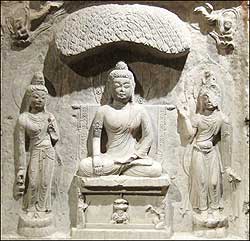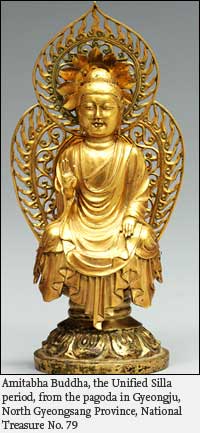
|
|
|
Home Asia Pacific North Asia S/N Korea History & Archaeology Lost Treasures Make Trip Home to KoreaBy Chung Ah-young, The Korea Times, Dec 24, 2008Seoul, South Korea -- Lost treasures from the Unified Silla Kingdom (668-935) have temporarily returned home for a special exhibition presented by the National Museum of Korea.
Titled ``Echoes of Life: The Enduring Tradition of Unified Silla Sculpture,'' the exhibition features 200 pieces of the kingdom's Buddhist sculptures, including 19 National Treasures and 17 Japanese cultural properties loaned from the Tokyo National Museum and the Nara National Museum. Particularly, five Korean artifacts, which were appropriated by the Japanese during the colonial era (1910-1945) - four Buddha statues and a reliquary - from the ``Ogura collection'' of the Tokyo National Museum are on display. Japanese businessman Takenosuke Ogura (1870-1964) collected some 1,100 Korean cultural pieces while he stayed in Korea and took them back to his country after Japanese colonial rule. Past Korean governments have accused the Japanese of plundering the artworks, mostly during that time.
In fact, the museum holds one of the largest and most significant collections of Korean art in the world, which is part of the legacy of looting during the Japanese colonial period. More than 1,000 gold, bronze, and celadon pieces and other relics owned by Ogura now make up the core of the museum's Korean section. It displays and houses about 4,800 Korean art pieces, of which more than 2,000 are considered antiquities. The Silla Kingdom conquered Baekje and Goguryeo and ended the Three Kingdoms, leaving a unique cultural heritage. Based on the openness and internationality of the Unified Silla Kingdom, it had strength in the arts, particularly sculpture, which transcended the limits of the region. The exhibition showcases rare collections ranging from a gilt bronze reliquary from the west pagoda at the site of Gameun Temple, Gyeongju, North Gyeongsang Province to a 179-centimeter-high gilt bronze Buddha statue from Baengnyulsa Temple, also in Gyeongju.
The first part shows the variety and diversity of the late 7th century sculptures, including the conservative Buddhist statues excavated in Yeongi, South Chungcheong Province, where ancient Baekje was situated, and a new style of statues with realistic depictions found in Gyeongju. The second part shows the essence of the Unified Silla sculptures, which incorporated the new styles of the 7th and 8th centuries. Particularly, visitors can compare the Silla sculptures with the Buddha Triad from Tang owned by the Tokyo National Museum. The third section displays the masterpiece sculptures of the 8th century, the peak era of its figurative artistry, spirituality and techniques through 20 gilt bronze pieces including the Buddha from the Baengnyulsa Temple, Gyeongju, North Gyeongsang Province; and Vairocana, the Buddha of Dharmakaya; and the Bhaisaiyaguru Buddha. The fourth section exhibits carvings that have the creativity and uniqueness of the Silla sculptures such as the Four Deities who guard the four cardinal directions and the eight classes of Sacred Beings. The fifth section presents tomb sculptures such as the zodiac figures, which gives a chance to look into perspectives of the afterlife of the people at that time. The sixth part recreates ``Seokuram,'' or a Buddhist sanctuary enshrining statues of Buddha inside a grotto, which was engrained with the artistic spirits of Silla, with modern interpretations. ``The exhibition is a good place for visitors to see the cultural heritage of the Unified Silla Kingdom at a glance. It is important to retrieve the looted historical artifacts but in separately move, it is also important to create an opportunity to help people make contact with the cultural heritage in Korea,'' an official of the museum said. The exhibition will run through March 1. For more information, call (02) 2077-9280. |
 |
|
| Korean Buddhist News from BTN (Korean Language) |
|
 |
|
|
Please help keep the Buddhist Channel going |
|
| Point
your feed reader to this location |
|

 << Buddha Triad, China, Tang period, from Tokyo National Museum
<< Buddha Triad, China, Tang period, from Tokyo National Museum The event is divided into six parts in which visitors can learn of the changes of the sculptures in accordance with the times.
The event is divided into six parts in which visitors can learn of the changes of the sculptures in accordance with the times.

